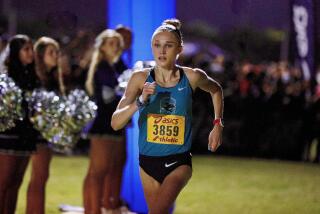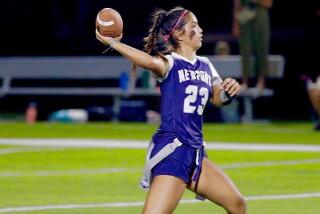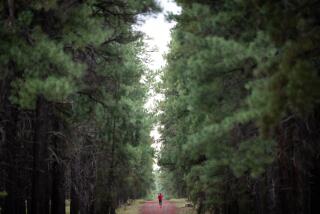ANSWERING Nature’s call
It’s football weather, almost everybody seems to agree, as though longer shadows and shorter days, morning dew and evening goose bumps somehow translate into Mother Nature’s sanction of smash-mouth aggressiveness and the West Coast offense.
Among a few other people, however, the subtle shifts of autumn evoke a different force of athletic habit. These folks can’t consider the flutter and crunch of a single golden leaf without getting the urge to race across a landscape carpeted with them. They don’t deny football’s place in the annual ambience. For them, however, stadiums and radios and newspapers and TV screens full of football are just signals of something more important--the arrival of the cross-country season.
“Something about this time of year makes it seem so natural to be training--not just running, but training--for a race,” says Dave Goforth, 45, an insurance salesman from Mission Viejo who began running as a teenager. “Maybe it’s because I’ve been doing it since 1967. The feeling of excitement and energy reminds me of high school. I don’t want to lose it.”
Lois Calhoun, 60, who began running four years ago when she relocated from Texas to Huntington Beach, feels the same.
“There’s something about the weather, the stronger breeze and the cooler temperatures after a long, hot summer. It makes me feel like moving around,” she says.
Some cross-country runners do it purely for their own enjoyment; some connect with others for company on the trail, and others team up to compete in events that can be of any distance but generally range from 2K to 10K.
William Feliciano, 29--a two-time Orange County cross-country champion and a 4:12 miler when he competed for Cypress High School in the mid-’80s--returned to cross-country this fall after an 11-year absence. He quit his teaching job and joined the team at El Camino College in Torrance.
“Something just gave me the urge to compete again,” Feliciano says. “I never quit doing it for fun--running is my life, if you want to put it that way--and now I can put myself into racing cross-country seriously again.”
Loneliness is not a problem for long-distance runners during cross-country season. Not for long-distance running-shoe salespeople, either. Business booms at this time for year.
“Part of the arrival of the cross-country season usually means buying new training shoes and racing flats,” says Dave Reynolds, who owns a Snail’s Pace, a running-equipment store in Huntington Beach.
Measured by participation, cross-country is among the most popular high school sports. More than 72% of the CIF Southern Section’s 500 schools fielded boys and girls teams in 1995.
“Cross-country is right up there, just behind the so-called major sports--football, basketball and softball,” says Art Munda, CIF spokesman. “And some of the best cross-country teams are in Orange County.” Boys’ teams from Santa Ana, Katella and El Modena high schools won CIF section championships last year, as did girls’ teams from Los Alamitos, Santa Margarita and El Modena.
Signs of cross-country season abound among older runners too.
Perhaps you’ve noticed formerly lone runners gathering into small packs during training sessions. Maybe you’ve seen chalk arrows on a park lawn or the dirt of a remote trail. How about the crowd that gathers at Mile Square Park in Fountain Valley on Monday and Wednesday evenings for runs? Or the group that assembles on the Cypress College track for Tuesday workouts? Registration tables at weekend 10Ks get more congested at this time of year too.
More than 700 runners of all ages inaugurated the 1996 cross-country season in Orange County a few weeks ago by racing across the varied terrain of Central Park West in Huntington Beach, the 12th renewal of a burgeoning tradition known as Sunset in the Park. The enthusiasm among the men and women, boys and girls who darted through the trees, around the lake, up the hills and along the trails in races of 2.8 miles and 4.8 miles seemed almost pagan--an All Soles Day, you might say.
What’s the appeal?
“Cross-country gives you a totally different physical and emotional feeling compared to running on the roads or on a track,” says Oscar Rosales, 57, race director of Sunset in the Park and several other cross-country races. “You’re not only observing nature; you are becoming part of it--running across grass, dirt, hills, mud. You can smell nature. You can feel it. It is you. And it is everyone else who is out there.”
Tom Pontac, a computer salesman from Huntington Beach, has been running for 19 years--he started when he was 41--and the allure of autumn was a big part of the attraction.
“When I discovered running in the dirt--cross-country--I was sold,” Pontac, 60, says. “It doesn’t get any better than running in Crystal Cove or Carbon Canyon, straining to run up a hill, enjoying the view, then that feeling of satisfaction as you come down. You can run the same trail every week, and it is always somehow changed. It is really a spiritual experience--sort of a church of the open road.”
But cross-country is more than just an athletic meditation. It is sport at its most basic--a footrace from here to there, with scant consideration of conditions in between. Fields and streams, sticks and stones, mountains and molehills. They’re all apt to be a part of the course.
“I always had an on-and-off relationship with cross-country because I have really weak ankles,” says Feliciano, who is still adjusting to his return to the sport. “It’s fun, but it’s frustrating when I have to sit out a week or two.”
Distances in cross-country are approximate. Time is irrelevant. Place is all important because team scoring is so elementary. First place gets one point, second place two, third place three and so on. A perfect score--1, 2, 3, 4, 5--is 15 points. A 1-2-3 sweep is unbeatable.
“Because of the variance in courses, it’s difficult to judge your improvement,” Feliciano says. “It’s also hard to deal with some people being better on some courses than others. Success isn’t specific to one person. But that’s one of cross-country’s charms.”
So is its anonymity.
Cross-country seems certain to be virtually ignored for as long as it shares the same season as football. After all, Grantland Rice didn’t compose sportswriting’s most famous lead--”Outlined against a blue-gray October sky, the Four Horsemen rode again . . .”--about the Notre Dame cross-country team, even though the university had a very good one in 1924.
But cross-country aficionados owe a debt to that other game of fall--it is after all the football game on TV that has triggered more than one armchair athlete to leap up and break into a jog.
“There seems to be a resurgence of people in their 40s and 50s, people who used to run and want to get that feeling again,” says Jeff Tribole, 43, proprietor of Runner’s High in Long Beach.
“Something about this time of year brings it out in them. It gets darker earlier; the air gets crisp; the wind starts blowing, and they find themselves saying, ‘Hey, let’s go and run through a park or something.’ ”
More to Read
Sign up for The Wild
We’ll help you find the best places to hike, bike and run, as well as the perfect silent spots for meditation and yoga.
You may occasionally receive promotional content from the Los Angeles Times.






